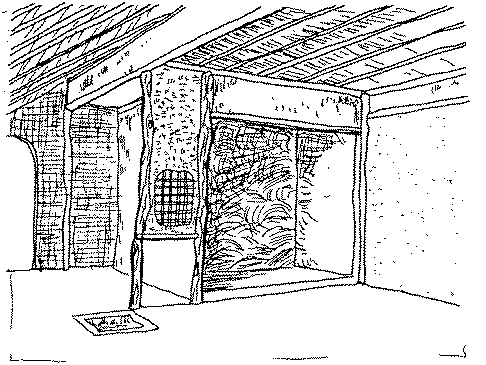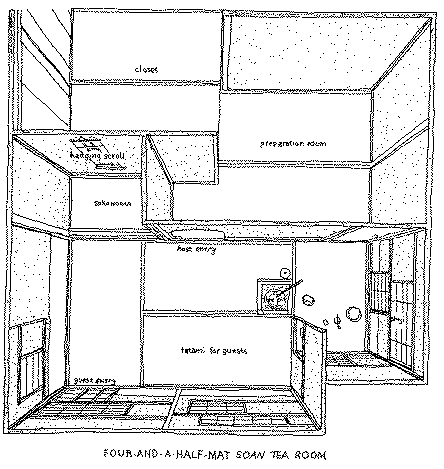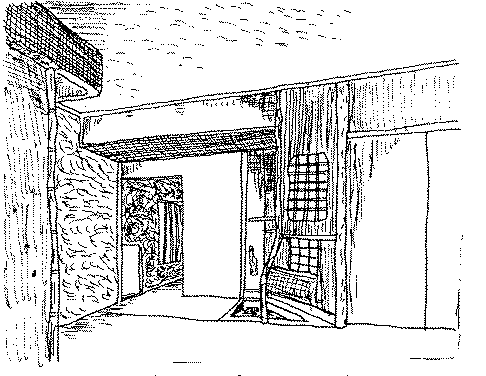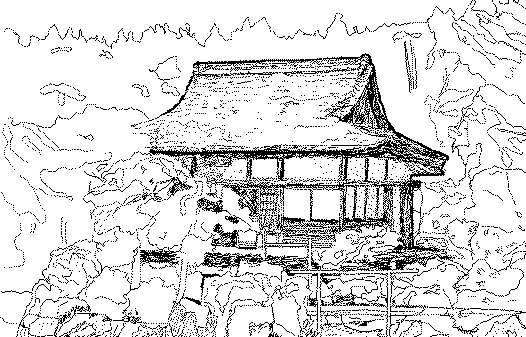Sukiya-zukuri,
The
Rose.
All mysteries
In this one flower meet
And intertwine
The universal is concrete,
The human and divine,
In one unique and perfect thing, are fused into a unity of love,
This rose as I behold it.
G.A. Studdert-Kennedy
Prelude
The true mysteries of this world defy stagnation.
They are alive. They constantly move. There are no rules
where these mysteries are concerned. Sometimes there seem to be,
but as soon as you think so . . . well then there is that exception.
The masters have accepted this.
They delight in this. How boring it would be otherwise!
Some might say
that the masters are all a bit "trans-logical"
the Picassos, the Van Goughs, the Lao-Tzus.
In their own ways they all unite the two-s in this world
into one-s.
The painting and I aren't two,
we're one.
The garden and I aren't two, nope . . one.
The truth and I? ... You guessed it,
won.
A group of these unifiers called Zen monks actually made a kind
of institution out of their one-ness. Out of their ranks, through the years, have come
many profound "answers" to the mysteries . . . many "roses," if you
will. One of these delights is the topic of this paper. This beauty came out of Japan
around the 16th century. It was called Sukiya-zukuri, a building technique derived from
the tea ceremony. It sought to unite many two-s into one-s, for those who were sensitive.
Of these two-s were the natural and built environment, man and man, and others.
Please read on for a look at this mysterious dynamic architectural rose,
and e-mail us your thoughts (archmaui@mauiboy.com).
INTRODUCTION
There is a certain charm of simplicity and
refinement associated with the traditional architecture of Japan. The atmosphere created
by this characteristic is very comfortable while at the same time subtly stimulating. It
is an attribute which took many centuries to develop, being inspired by the minka
farm dwellings of ancient times and reaching it's peak of development near the end of the
sixteenth century with a style of building called Sukiya.
In spite of the fact that this environmental
grace was accomplished not by architects per se but, for the most part, by Zen monks, the
style has had a significant effect on modern architecture by influencing such masters as
Frank Lloyd Wright and Mies Van Der Rohe. This paper will examine the Sukiya style
of building in which this refined simplicity of Japan achieved perfection.
Looking back ...
The architectural history of Japan is divided into three
periods. The first is called the "Protohistoric Age." This era stretched from
the earliest times of the Japanese nation up until Buddhism first came to Japan from
China. No major distinction was made during this period between the style of buildings for
commoner's dwellings, palaces and shrines. The second period lasted from when Buddhism
entered Japan (552 AD) until 1867, the final year of the Tokugawa Shogunate. As Buddhism
came to Japan, so did the influence of "Continental" (Chinese and Korean)
architecture. This influence was very strong in earlier centuries of this era and
gradually declined as time went on. The third period, which extends from 1868 until the
present, is characterized by the construction of western style buildings in Japan.
Architecture in Japan has now become international in style, rather than strictly
oriental.
Due to the fact that the second period spanned more than
1300 years, it has been subdivided into seven "mini-" periods. Briefly, they
were:
- The Asuka Period (552-644), when Buddhism came to Japan and
the major focus of architecture was on temples. What is particularly noteworthy about this
era is the beautiful proportions which were achieved within the temples. An example of
this particular beauty is the Koryuji Temple, which still exists today.
- The Nara Period (645-783) which was characterized by the
predominance of Chinese arts and crafts.
- The Heian Period (784-1185) in which communication with China
became less frequent; and thereby, Japanese architecture became more native. The "Shinden"
style of building was developed during this period, a style which was still predominantly
"continental" in character. Gradually the scale of the massive timber buildings
was made more human.
- The Kamakura Period (1186-1392) during which the Samurai
(warrior) class gained considerable power (establishing the Shogunate at Kamakura) and the
Zen sect of Buddhism was introduced to Japan re-establishing cultural intercourse with
China. The Zen monks brought with them a somber and heavy style which came to be called
"Kara-yo" ("foreign-style"). This style had merged with the
styles of previous periods by the end of this era.
- The Muromachi Period (1393-1572), which was characterized by
the continuation of the evolving Kara-yo and Shinden styles. Significant
progress was made in skillful workmanship during this time, with an emphasis on
ornamentation and the more delicate use of timber. After the civil war of Onin (1460) the Shinden
style of construction was used much less and a new refined pattern began to emerge called Shoin.
- The Momoyama Period (1573-1614), which saw the perfection of
the Shoin style with a mellow grandeur and enrichment of ornamentation indicative
of its primary inhabitants, the Samurai. During this period another, even simpler and more
native style developed: Sukiya, the primary topic of this paper. With time, as Sukiya
evolved out of the Shoin method, it stripped itself of ornamentation and changed
from "Shoin-like Sukiya" to "Soan-Sukiya." The Sukiya
style was strongly influenced by Zen philosophy as will be discussed later.
- The last period of the second major era of Japanese history
was the Edo Period (1615- 1867), During this time Japan was ruled by decree, isolated from
the outer world. This led to a general apathy in architectural style until 1868, when the
third major era began and western buildings came to Japan.
The Chashitsu, A Spot for Tea
The Sukiya style of building thus evolved out of a
long history of techniques each of which added something new while discarding what was
unwanted. Certain aspects of style remained relatively constant throughout this evolution:
the buildings were always made chiefly of wood and great pride was taken in their
craftsmanship, and there was always a distinct relationship to the natural environment
(perhaps because Japan's natural environment is so beautiful and basically gentle, and
because the hot, humid conditions during the summer generally necessitated that the
buildings be quite opennable for ventilation). In Sukiya style architecture, these
"constant elements" which had persisted through history were brought to an
exquisite perfection by sensitive arrangement and simplification. This was accomplished
largely because the men who developed Sukiya were Zen monks, whose whole lives were
dedicated to the contemplation of the essence of life. Basically, the lives these men
lived enabled a few of them to strip away all of the "husks," if you will, which
had existed in the previous styles, and get down to the "meat" (the kernel) of
just what it was that made wooden construction, in this particular environment, pleasing
to the human senses.
Sukiya is a style for designing domestic buildings in
general which was derived from a technique for creating a particular type of building: the
tea house, or chashitsu. The purpose of the chashitsu was to provide a place
to perform the tea ceremony, or cha-no-yu, which was developed in Japan by certain
Zen monks from about 1420 on. The form to the chashitsu, which gave rise to the
forms of Sukiya, followed directly from its function. This was, on one level,
simply to unite a small group of people (five or six at the most) in a relaxed communion
over a cup of tea. On another level, the ultimate aim of cha-no-yu was "the
attainment of a deep spiritual satisfaction through the drinking of tea and through silent
contemplation ". [2]
The ceremony of cha-no-yu was (and is) a unique form
of art which combined a highly refined version of the Chinese custom of tea drinking with
certain aspects of Zen philosophy. When the social custom of drinking tea first came to
Japan, the nobility would hold parties at which a number of different varieties of tea
were served. A game came into vogue which consisted of the guests trying to guess where
the tea being served originated. As tea drinking became more popular a portion of the
host's residence was partitioned off for this activity with ornamental screens. The tea
was prepared by servants using lavishly decorated and exquisitely crafted utensils which
attested to the high status and good taste of the host.
As time went on, separate buildings were constructed for the
sole purpose of drinking tea. Certain Zen monks, who had gained a reputation for their
ability to prepare and serve tea, were retained by the wealthy expressly to perform this
function. These priests became known as tea masters. One of these masters was Murata Shuko
(1422-1502), who has become known as the father of the tea ceremony.
Shuko initiated certain important procedures which differed
from what was practiced by other tea masters. Rather than serving tea to large gatherings,
Shuko preferred having a group of no more than five or six people in order that the affair
would be more intimate and personal. For a similar reason, he would not have servants
prepare and serve the tea, but insisted that he himself, as "host" should do
this as a gesture of friendship and respect for his guests. These ways of serving tea
became fundamental to future tea ceremonies. Shuko was also one of the best designers of
the tea room, which he kept a small four-and- a-half mat (about nine square yards) in
order to create a more tranquil atmosphere than had hitherto been accomplished with the
normal Shoin room. It is said that the size of this (now) orthodox tea room was
determined by a passage in Buddhist scripture in which a holy person welcomed 84 thousand
disciples of Buddha into a room of this size, -- an allegory based on the theory of
non-existence of space to those who have reached enlightenment. [4]
After Shuko, a monk named Jo-o (1505-55) and another called
Rikyu (1522-91) added the finishing touches to what is now called cha-no-yu.
Rikyu's contribution to the tea ceremony cannot be over-estimated. He is the founder of
the ceremony as it is practiced in Japan today. Rikyu made the art of tea much less formal
than Shuko. His primary objective was to put all participants in the ceremony at ease.
Everything to do with his process had this end as its objective. He taught that the proper
spirit which should saturate cha-no-yu consisted of four elements: harmony,
reverence, purity, and tranquillity. He believed that, in general, man was too egotistic,
too worried about protecting himself from other human beings and the world in general.
Rikyu sought to create, through the art of tea, an atmosphere of such tranquillity that
men would feel no threat from the world. Out of this tranquillity an individual would
achieve an intuitive sense of the harmony which exists within nature, and the purity of
heart which an understanding of this harmony nurtures. This purity, Rikyu felt, would give
a person such a state of well-being that a reverence for all of nature's creations would
follow. The tea ceremony was ideally an escape from the day to day world of anger and
jealousy, self-pity and the need for self-defense. Rikyu believed it could aid
substantially in man's quest for self-knowledge and self-contentment.
Indeed, to Rikyu, the art of tea and Zen were
the same thing. The ceremony performed a similar function to meditation. The only
difference was in appearance, in the forms. It is ironical that "while Zen teaching
consists in grasping the spirit by transcending form, it unfailingly reminds us of the
fact that the world in which we live is a world of particular forms and that the spirit
expresses itself only by means of form." [5] The two are actually one. The message is
the medium; and it transcends the medium.
Perfection from the Imperfect
Rikyu saw in the form of cha-no-yu and
all the tools which were used in its performance (including the tea house, chashitsu)
great potential to put men at ease, to open their minds to a peaceful spirit he called
wabi. In order to help men achieve an understanding of wabi, the teamaster's job was to
put this spirit into every object involved within the tea ceremony. In a sense, wabi means
"down to earth" or "natural goodness." It implies a sense of poverty.
Because of this, Rikyu taught, the objects of the tea ceremony could not be ornate or
ostentatious, but instead had to contain certain natural imperfections; not just any old
imperfections, but special "flaws" which subtly showed the spirit or wabi which
they embodied. Rikyu invented the technique of making Raku pottery in order to create tea
utensils with wabi. The tea houses he designed were derived not from the rich and lavish Shoin
style homes and pavilions of the nobles, but from the native working peoples "minka"
huts. Their walls were hardened mud. Their wooden members were for the most part rough
logs, sometimes with their bark still on. Cut lumber was used sparingly to accentuate the
rough logs by contrast. Small bamboo-mullioned shoji (translucent) windows were
employed to allow a soft natural light to fill the room. The roof was made of thatch, the
underside of which could be plainly viewed from inside the chashitsu. The thatch
seen through the rough wooden rafters produced a beautiful texture contrasted against the
mud walls.

One's ability to perceive the wabi which was
contained within the materials selected for the chashitsu was enhanced by the
sensitive arrangement of these materials by the tea house designer. The sensitivity which
went into an arrangement intended to heighten the tranquil atmosphere produced by wabi
was called sabi. That is to say, sabi is the objective sensitive ability to
manipulate certain materials which contain a particular subjective spirit of rustic
peacefulness called wabi. Sabi is similar to wabi in that it also
insists that perfection be hewn from imperfection (here we see that
"trans-logic" of the masters again ...). The perfection of sabi depends
on its imperfection or incompleteness, just as the wabi within an object depends on
its crudeness or rusticness. To be perfect the materials and the composition must be
imperfect. What is accomplished when an environment is created with wabi and sabi
is that the inhabitant becomes intimately involved with his surroundings. By a natural
process similar to what artists call closure," he will "fill in the gaps"
which skillful use of wabi and sabi have left in his environment. He will
finish the composition in his mind, and by doing this it will become a part of him and he
a part of it (the two are one!). Rikyu discovered this value of suggestion through Zen and
implemented it into every aspect of cha-no-yu. A person capable of totally
implementing this perfect imperfection had what Rikyu called "chado" or
"tea-mind."
The tea hut was set off from the house proper in a wabi
natural environment. Half the fun was getting there. Through a mysteriously beautiful
garden, designed with sabi, the guests to the tea ceremony would silently follow a
trail called a "roji," The roji led to the chashitsu from a
roofed arbor from which the guests would be summoned. The purpose of the roji was
to break the guests connection with the outside world, physically and spiritually, and to
produce a feeling of freshness conducive to the complete aesthetic appreciation of the tea
ceremony which was to come (kind of like splashing cool water in your face in the morning
to wake up). Roji literally means "dewed ground,” an expression which
comes from Buddhist teaching: "One stands on the white-dewed ground after leaving
this world of flaming passions. " [6]
The tea masters showed great ingenuity and sabi in
designing the roji and garden. Although the site might be in the midst of a large
city, and the garden fairly small, it would seem as though you were in a deep mystical
forest. Great care was taken to gently awaken all the senses: the sound of water trickling
softly, or of small loose pebbles as the guest took a few steps across them; the changes
in texture which were seen and felt underfoot as the path went from pebbles to pine
needles to fit stone to boulder bridge over a small stream to individual stone pads placed
a footstep apart to the tatami (straw mat) floor of the chashitsu; the smell of the
pine needles, of the earth freshly sprinkled with water before your arrival, of the
incense coming from the tea hut; the taste and feel of the fresh, cool water as you rinsed
your mouth and hands at the stone basin before entering the chashitsu. Every detail
was considered. The garden and tea house were swept scrupulously before each ceremony, but
even then, after the teaching of Rikyu, a branch might be shaken over the roji
allowing a few leaves to grace the path with the perfect imperfection of sabi.
Prepared by his refreshing stroll to the hut
the guest silently approached, leaving his sword (if he were Samurai) on the rack below
the eaves. He would then bend low and creep into the room through a small door, usually
about twenty-seven inches in height and about twenty-three inches in width. This coerced
bow as the guest entered was intended to instill humility. No matter what your rank or
status out in the "real" world, when you were in the chashitsu you were
simply a human being.
Form
The layout of the "standard" chashitsu as
set forth by Rikyu is shown in the following drawing.

Notice that the floor is raised only in the
"tokonoma," or alcove, which contains a scroll. The reason for this was, again,
that no show of one-up-manship or status would invade the peaceful atmosphere. On the
scroll was a short phrase of wisdom which was appropriate to the season in which the cha-no-yu
was taking place and the special meaning of this particular ceremony, with these
particular guests, as understood by the chado (tea-mind) of the host. The raised platform
indicated that this was what would be honored. There might also be a lone flower in a vase
on the platform (placed with sabi, of course) or an arrangement of celebrated tea
articles of ancient origin.
The ceiling of the hut was generally kept low to enhance the
intimacy of the gathering. But in order to avoid a cramped feeling it was varied in
certain places. Over the alcove it was raised to show honor for the scroll and revered
articles. Over the host's seat it was lowered to show his humility. The ceiling made by
the underside of the naturally sloping roof had the beneficial effect of making the room
seem larger than it actually was.
The walls, as mentioned before, were made of mud with logs
being used as supporting posts and lintels. These elements produced a soft, warm texture
which was accentuated by the soft light coming in through the bamboo-grilled shoji
windows. All openings in the walls were intentionally placed off-center and often near the
floor to break up any sense of symmetry (in the spirit of sabi) and so that the
light and (if the window was open) ventilation and view would be in the appropriate spots.
All other features of the chashitsu -- semi-free
standing posts, lintels, frames, ledges -- were designed to be as light and fragile as
possible. Extreme care was taken to provide an aesthetic balance between their height and
width.

These ideas, inherent in sabi, of
asymmetrical design, variety, and aesthetic balance were carried out in every aspect of
the chashitsu: the ceiling heights, textures, lighting, sizes of the rectangles
made by different shoji grills, arrangement of the tatami floor mats, seating of the host
and guests, . . . everything. What was created was a poem of the eternal in building form,
a stimulating yet peaceful piece of Haiku, written in mud, logs, straw, paper and tea.
"The eternal is to be found only in the spirit which, embodied in these simple
surroundings, beautifies them with a subtle light of its refinement." [7]
Achieving Simplicity
During the turbulent time in Japan's history of wars,
battles and violent changes of political power, the tranquil spiritual atmosphere of the
tea ceremony and tea hut was an extremely welcome change for the military commanders. When
peace finally came under the Tokugawa Rule, these men of war turned to the arts of cha-no-yu
and the Noh play as essential parts of their education and entertainment. Nearly all of
these warriors, even those of lower rank, built tea houses or tea rooms in the style of cha-no-yu,
called Sukiya.

The now fashionable ceremony of tea spread even to the
common people, and the design sensitivity of Sukiya followed, becoming widely
adopted for domestic building. This produced a fresh, lighter and freer form of domestic
architecture in contrast with the Shoin style which had been prevalent. Sukiya-zukuri
(or the tea house style of building) was especially favored for garden pavilions and
villas, two fine examples of which are the Katsura Imperial Villa in Kyoto and the
Rinshunkaku building of the Sankeien garden in Yokohama. The simple elegance of these
environments is magnificent and timeless; their proportions and use of materials truly
inspiring. Sukiya had reached a peak of perfection. But then the ideals of wabi
and sabi of the early Sukiya style began to give way to a competitive
passion for rare materials and complex craftsmanship. This was especially so in the town
houses of the wealthy merchant class, who had been forbidden to build Shoin style
residences. Eventually the Shogunate forbade even the construction of tea houses and other
Sukiya buildings by the town folks. Only the privileged could inhabit such
dwellings. What began from the pure and simple wisdom of the common man had degenerated in
the world of "flaming passions" into just another status symbol.
The spirit of cha-no-yu was never lost though.
Architecturally it has resurfaced in the twentieth century through men such as Sutemi
Horiguchi, the author, and others specializing or experienced in Sukiya-zukuri.
Horiguchi's Hotel Hassho-kan, built in 1950 in Nagoya is a building rich in the spirit of Sukiya.
In this work "Horiguchi has succeeded in introducing a striking modernity to a
structure which is built according to the traditional principles of wooden
construction." [8] The tea master would not have it any other way. Surely one cannot
capture the spirit of Sukiya by merely copying what has already been done.
"The present is the moving infinity, the legitimate sphere of the relative.
Relativity seeks adjustment; adjustment is art. The art of life lies in a constant
readjustment to our surroundings." [9]
Thus the study of Sukiya and the state of mind which
inspired its birth and development is no less important now than it has ever been. Perhaps
it is more important as we now move further and further from the world of wabi into
the slick "perfect perfection" of technology. We will always be humans, animals,
who must feel our nature every so often to keep our sanity. A rose is a rose is a rose. A
human is a human is a human. A human is a rose is a frog ..., sweet prince. What we need
to do more of is (ribbit) leap off our lily pads into the cool water of our nature ... to
turn full circle and reunite with where we came from. It's in a baby's eyes, in a puppy's
bounce, and in the delight of Sukiya. Simplicity.
"If your ears see,
And your eyes hear,
Not a doubt you'll cherish ...
How naturally the rain drips
From the eaves!" |